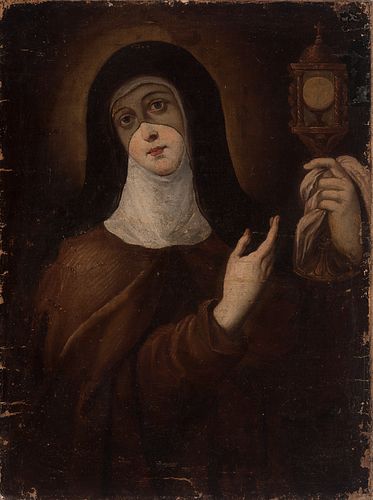Andalusian school; XVII century. "Santa Clara". Oil on canvas. Presents chips in the pictorial layer and precises cleaning.
Lot 8
About Seller
Setdart Auction House
Carrer Aragó 346
Barcelona
Spain
Setdart Subastas was born in 2004 and is currently the first online art auction in Spain with solidity, prestige and reliability guaranteed by our more than 60,000 users. Setdart has a young, dynamic and enterprising team ready to successfully manage the purchase and sale of art works through custom...Read more
Estimate:
EUR€500 - EUR€600
$526.32 - $631.58
Absentee vs Live bid
Two ways to bid:
- Leave a max absentee bid and the platform will bid on your behalf up to your maximum bid during the live auction.
- Bid live during the auction and your bids will be submitted real-time to the auctioneer.
Bid Increments
| Price | Bid Increment |
|---|---|
| EUR€0 | EUR€10 |
| EUR€200 | EUR€25 |
| EUR€500 | EUR€50 |
| EUR€1,000 | EUR€100 |
| EUR€3,000 | EUR€200 |
| EUR€5,000 | EUR€500 |
| EUR€10,000 | EUR€1,000 |
| EUR€20,000 | EUR€2,000 |
| EUR€50,000 | EUR€5,000 |
About Auction
By Setdart Auction House
May 31, 2021
Set Reminder
2021-05-31 08:30:00
2021-05-31 08:30:00
America/New_York
Bidsquare
Bidsquare : OLD MASTERS - Day 1
https://www.bidsquare.com/auctions/setdart-auction-house/old-masters---day-1-6998
Setdart Auction House sofia@setdart.com
Setdart Auction House sofia@setdart.com
- Lot Description
Andalusian school; XVII century. "Santa Clara". Oil on canvas. Presents chips in the pictorial layer and precises cleaning. Measures: 89 x 66.5 cm. St. Clare of Assisi was an Italian saint born in 1193 into a wealthy and powerful family. From a very young age she was assiduous in prayer and mortification, detached from worldly things and deeply spiritual. She felt great compassion and love for the followers of St. Francis, whom she cared for and provided for through a maid, since she was forbidden to see and speak to them. Her conversion to a life of full holiness was effected when she heard a sermon of St. Francis of Assisi in 1210, when she was eighteen years old. Two years later she ran away from home and went to live with a group of nuns close to St. Francis. Saint Clare was the foundress of the Poor Clares, becoming superior of the convent of San Damiano, always showing great dedication and deep spiritual strength. During her lifetime she performed several miracles, and shortly after her death, in 1255, she was canonized by Pope Alexander IV. Her main iconographic attribute is the monstrance, although she can also carry a crosier, due to her character of foundress of the Poor Clares, and a lily, symbol of purity. The 17th century marked the arrival of the Baroque in the Andalusian school, with the triumph of naturalism over Mannerist idealism, loose workmanship and many other aesthetic liberties. At this time the school reached its greatest splendor, both for the quality of the works and for the primordial rank of Sevillian Baroque painting. Thus, during the transition to Baroque we find Juan del Castillo, Antonio Mohedano and Francisco Herrera el Viejo, in whose works the rapid brushstroke and the crude realism of the style is already manifested, and Juan de Roelas, introducer of Venetian colorism. In the middle of the century the period reached its peak, with figures such as Zurbarán, a young Alonso Cano and Velázquez. Finally, in the last third of the century we find Murillo and Valdés Leal, founders in 1660 of an Academy where many of the painters active during the first quarter of the 18th century were trained, such as Meneses Osorio, Sebastián Gómez, Lucas Valdés and others.
- Shipping Info
-
In-house shipping available. Please inquire at admin@setdart.com.
-
- Buyer's Premium



 EUR
EUR CAD
CAD AUD
AUD GBP
GBP MXN
MXN HKD
HKD CNY
CNY MYR
MYR SEK
SEK SGD
SGD CHF
CHF THB
THB














